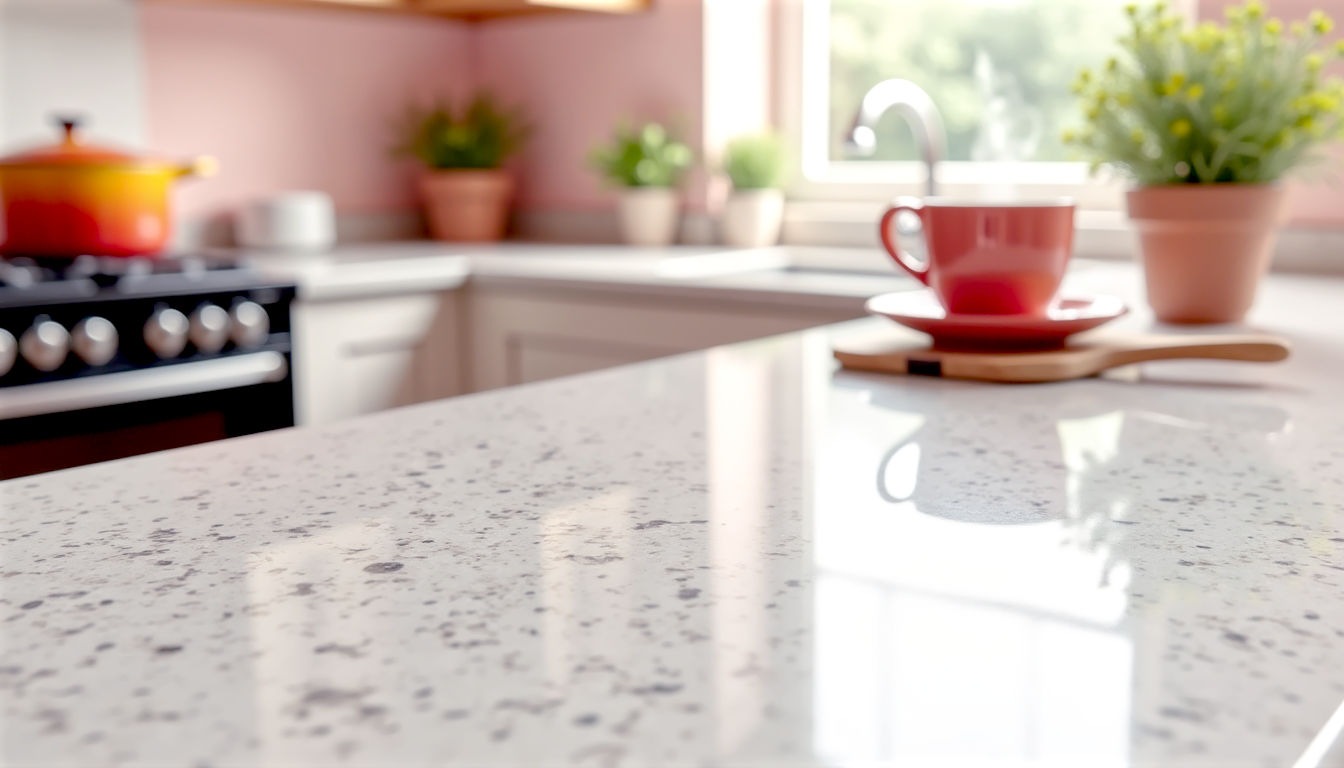The Great Granite Debate: Is This Kitchen Classic Still a Solid Choice for British Homes?
Is granite outdated? We settle the debate for British homeowners, comparing it to quartz, exploring modern styles, and covering UK costs and maintenance.

This post may contain affiliate links. If you make a purchase through these links, we may earn a commission at no additional cost to you.
Picture this: you’re watching an old episode of Grand Designs. A couple, full of hope and slightly over-budget, are proudly revealing their brand-new kitchen. And there it is, gleaming under the spotlights – a swathe of polished, speckled granite. For decades, granite was the undisputed king of the British kitchen, a symbol of good taste and solid investment. It was the worktop you got when you’d ‘made it’.
But times change. Flick on a design show today, and you’re more likely to see sleek, uniform quartz, rustic wooden surfaces, or edgy industrial concrete. Whispers have started in showrooms and online forums: is granite a bit… dated? Has this once-mighty stone gone the way of avocado bathroom suites and swirly-patterned carpets?
It’s a question that plagues anyone planning a kitchen renovation. You want a worktop that’s beautiful, tough as nails, and won’t look old-fashioned in five years. So, what’s the verdict on granite? Is it a relic of the past, or is it a timeless classic that’s simply misunderstood?
Well, let’s settle the debate. This isn’t just an article; it’s the ultimate guide to understanding granite in the modern British home. We’ll dig into its incredible journey from deep within the Earth, explore why it became so popular, and pit it against the new kids on the block. By the end, you’ll know for certain if granite is the right choice for your home, or if it belongs in the history books.
What Exactly Is This Stone We Call Granite?
Before we decide if it’s outdated, let’s get our hands dirty and understand what granite actually is. It’s not something cooked up in a lab; it’s a 100% natural product, courtesy of Mother Nature.
A Rock Star Is Born: The Simple Science
Imagine a giant, bubbling pot of melted rock deep beneath the Earth’s surface. This molten rock is called magma. Over millions of years, this magma slowly, very slowly, cools down and hardens. As it cools, different minerals crystallise and lock together, like a chaotic, beautiful jigsaw puzzle.
The main ingredients in this geological recipe are quartz and feldspar, with a sprinkle of other minerals like mica and amphibole. It’s the unique mix of these minerals that gives each slab of granite its distinctive colour and pattern.
- Quartz usually provides the milky white or greyish, semi-transparent bits.
- Feldspar is the chalky-looking mineral that can be pink, white, grey, or even blue.
- Mica adds the sparkly, glittery flakes you often see.
- Darker minerals like amphibole create the black and dark green specks.
Because this process is completely natural and random, no two slabs of granite are ever the same. The slab in your kitchen is a one-of-a-kind piece of art, millions of years in the making. This uniqueness is one of its biggest selling points.
From Quarry to Kitchen: An Epic Journey
Getting that slab from a mountainside into your home is quite the adventure.
- Quarrying: Giant blocks of granite, some weighing over 20 tonnes (that’s about the weight of three double-decker buses!), are carefully cut out of mountains in places like Brazil, India, Italy, and China.
- Slicing: These huge blocks are transported to a factory and sliced into more manageable slabs, usually about 2-3 centimetres thick, using massive diamond-wire saws.
- Polishing: The surface of each slab is ground down and polished with finer and finer abrasive pads until it has that classic, mirror-like shine we all recognise. Sometimes, a “honed” (matte) or “leathered” (textured) finish is applied instead for a more modern look.
- Fabrication: This is where it gets personal. A local stone fabricator takes the slab you’ve chosen, cuts it precisely to fit your kitchen layout, and cuts out holes for your sink and hob.
- Installation: Finally, the finished pieces are carefully delivered and installed in your home, sealed to protect them from stains, and ready for action.
So, when you run your hand over a granite worktop, you’re touching a piece of ancient geology that’s been on an incredible global journey. It’s not just a surface; it’s a story.
How Granite Became the King of the Kitchen
Granite wasn’t always the go-to choice for the average British home. For a long time, it was reserved for banks, fancy hotels, and the gravestones of the wealthy. So, how did it make the leap into our kitchens?
The Rise of ‘Aspirational’ Kitchens
Back in the 1980s and 90s, the kitchen’s role began to change. It was no longer just a small, functional room hidden at the back of the house. Thanks to TV chefs like Delia Smith and the rise of open-plan living, the kitchen became the heart of the home – a place to entertain and show off.
People wanted their kitchens to look impressive. Laminate and tile worktops, which were common at the time, just didn’t cut it anymore. Homeowners started looking for materials that said “quality,” “luxury,” and “permanence.”
Granite fitted the bill perfectly. It was tough, it was beautiful, and it was expensive enough to feel exclusive. As property prices boomed in the late 90s and early 2000s, installing granite countertops became a sign of success. It was the kitchen equivalent of parking a brand-new BMW on the drive. TV shows like Changing Rooms and later Location, Location, Location cemented its status as the ultimate kitchen upgrade.
The Speckled Look: A Defining Feature
The most popular granites of that era were heavily speckled or patterned varieties, like Baltic Brown (a coarse, brown and black pattern) or Star Galaxy (a black stone with coppery, reflective flecks). These busy patterns were great at hiding crumbs and fingerprints, making them practical for family life.
For nearly two decades, these specific styles of granite dominated high-end kitchens across the UK. They were so popular that their look became synonymous with the material itself. And this, as we’ll see, is a key reason why some people now consider granite “outdated.”
The Great British Worktop Showdown: Granite vs. The Contenders
Granite doesn’t rule the kingdom alone anymore. A whole host of new materials have arrived on the scene, each claiming to be the next big thing. How does our old stone friend stack up against them?
This is where the real decision-making happens. Let’s break it down.
The Main Rival: Quartz
If granite is the old king, quartz is the heir apparent. Quartz worktops are now the most popular choice in the UK, and for good reason.
- What it is: Quartz worktops are engineered stones. They’re made by mixing about 90-95% crushed natural quartz with polymer resins and pigments. This mixture is poured into a mould, compressed, and baked to create a solid, non-porous slab.
- The Look: Because it’s man-made, quartz can be engineered to look however the manufacturer wants. You can get it in a huge range of colours, from brilliant white to jet black. Many popular designs mimic the look of marble or concrete, but with none of the maintenance headaches. Its patterns are consistent and uniform, which appeals to the modern taste for clean, minimalist lines.
Granite vs. Quartz: The Head-to-Head
| Feature | Granite | Quartz | The Verdict |
|---|---|---|---|
| Look & Style | Naturally unique. Every slab is different, with organic patterns and veining. Can be speckled, veined, or relatively uniform. | Consistent & uniform. Wide range of colours and patterns, including convincing marble and concrete lookalikes. | It’s a tie. Granite is for those who love natural, one-of-a-kind beauty. Quartz is for those who want a specific, controlled look. |
| Durability | Extremely tough. Highly resistant to scratches and heat. You can put a hot pan straight on it (though it’s not recommended!). | Very tough, but… Also highly scratch-resistant, but the resins can be damaged by extreme heat, causing scorching or discoloration. | Granite wins on heat resistance. For scratch resistance, they are very similar. |
| Maintenance | Needs sealing. Granite is naturally porous (like a sponge), so it must be sealed on installation and re-sealed every year or so to prevent stains from oil or wine. | Zero sealing required. The resins make it non-porous, so it’s naturally stain-resistant and very low-maintenance. | Quartz wins on ease of care. It’s the fit-and-forget option. |
| Cost | Variable. Prices vary hugely depending on the rarity of the stone. Can start from around £200 per square metre and go up to £700+. | Consistent. Generally priced in the mid-to-high range, typically £300 to £800+ per square metre. | Roughly comparable. You can find affordable and very expensive options in both materials. |
Other Popular Alternatives
It’s not just a two-horse race. Several other materials are vying for a spot in your kitchen.
- Sintered Stone (e.g., Dekton, Neolith): This is the new super-material on the block. It’s made by fusing natural minerals together under intense heat and pressure, mimicking how rock is made naturally but in a fraction of the time. It is virtually indestructible – completely resistant to scratches, heat, stains, and even UV light (so it won’t fade in a sunny kitchen). However, it is one of the most expensive options and can be brittle on the edges if something heavy is dropped on it.
- Solid Surface (e.g., Corian): Made from acrylic resins and minerals, solid surface worktops can be seamlessly joined, meaning you can have integrated sinks and no visible joins. They come in hundreds of colours. They aren’t as scratch-resistant as stone, but any scratches can be sanded out, making them repairable.
- Wood: A timeless choice that brings warmth and character to a kitchen. It’s perfect for traditional or country-style homes (think Cotswolds cottage). However, it requires regular oiling to prevent it from drying out or staining, and it can be scorched or dented.
- Laminate: The budget-friendly champion. Modern high-pressure laminates are much better than they used to be, with realistic stone and wood effects. They are easy to install and maintain, but they can’t compete with stone for durability or a premium feel.
So, Is Granite Truly Outdated?
Now for the million-dollar question. We’ve seen what granite is and where it comes from. We’ve seen its competition. Let’s tackle the “outdated” accusation head-on.
The truth is, it’s not granite itself that’s outdated, but rather the specific styles of granite that were popular 20 years ago.
The Curse of the Speckle
Think back to those busy, speckled patterns like Baltic Brown. They were everywhere in the early 2000s. Because they are so strongly associated with that specific era, they can make a kitchen feel dated today, in the same way that a particular shade of avocado green screams “1970s.”
These speckled granites don’t fit well with the current design trend, which favours:
- Clean, simple lines.
- Subtle, minimal patterns.
- Neutral colours like whites, greys, and blacks.
This is why quartz has become so popular. It delivers that clean, consistent look perfectly.
The Granite Renaissance: A New Look for a Classic Stone
But here’s the secret: granite can do that too.
The world of granite is vast. It’s not all about the speckles. In recent years, homeowners and designers have rediscovered more subtle and dramatic granites that look stunning in a modern kitchen. These “new-look” granites are shaking off the material’s dated reputation.
Look out for varieties like:
- Black Granite (e.g., Absolute Black, Nero Assoluto): Often available in a honed (matte) or leathered finish, this type of granite provides a sophisticated, uniform look that rivals black quartz. It’s chic, dramatic, and timeless.
- White Granite (e.g., River White, Kashmir White): These granites have a soft, light background with subtle veining and movement. They offer a beautiful, natural alternative to the ever-popular marble-effect quartz. They have a more organic feel than their engineered counterparts.
- Granites with Dramatic Veining: Some granites, like Viscon White or Cosmic Black, have bold, sweeping veins of colour that create a stunning focal point. They are like a piece of abstract art for your kitchen and are incredibly popular for statement island units.
When you choose one of these modern-style granites, you get the best of both worlds: the timeless, natural beauty of real stone and a look that is perfectly on-trend.
Practical Matters: Is Granite Right for Your British Home?
Let’s get down to brass tacks. Aesthetics are one thing, but how does granite perform in the daily life of a busy British household?
The Cost Factor
Granite is generally seen as a premium material, but its price can vary wildly. It’s priced in groups or bands, based on its rarity. A common, widely available granite might cost less than some high-end laminates, while a rare, exotic blue granite could cost a small fortune.
- Budget: £200 – £400 per square metre (installed).
- Mid-Range: £400 – £600 per square metre.
- High-End: £600+.
Top Tip: Always get quotes from several local, independent stone fabricators. They often have access to a wider range of slabs and can be more competitive on price than the big kitchen chains.
The Maintenance Myth
The biggest worry people have about granite is the maintenance. The word “porous” sounds scary, conjuring images of red wine stains that never come out.
Yes, granite needs to be sealed. But this is not the huge chore people imagine it to be. A good quality sealer, applied properly by the installer, will last for at least a year, sometimes longer. Re-sealing is a simple DIY job that takes about 15 minutes. You just wipe the liquid on, let it soak in, and wipe off the excess.
For daily cleaning, a simple mix of warm water and a drop of washing-up liquid is all you need. The main thing to avoid is harsh, acidic cleaners (like bleach or vinegar), as they can strip the sealer.
Hard Water Woes: In many parts of the UK, we have very hard water. This can leave limescale deposits around taps. On dark, polished granite, these white marks can be quite noticeable. They can be removed with a specialist cleaner, but it’s something to be aware of if you choose a dark, shiny surface. A honed (matte) finish is much more forgiving.
Durability: Built to Last Generations
This is where granite truly shines. It is one of the hardest natural materials on earth.
- Scratch-Proof: You can chop vegetables directly on it without leaving a mark (though you will blunt your knives!).
- Heat-Resistant: You can take a pan straight from the hob and place it on the surface without causing any damage. This is a key advantage over quartz.
- Tough: It’s incredibly difficult to chip or crack. With a little bit of care, a granite worktop will genuinely last a lifetime. It will likely outlast your kitchen cabinets, your appliances, and possibly even you!
This durability makes it a great long-term investment. While other worktops may need replacing after 10-15 years, granite just keeps going.
The Final Verdict: Classic or Cliché?
So, after all that, are granite countertops outdated?
The answer is a resounding no.
High-quality, beautiful stone will never truly go out of style. Granite is a timeless, durable, and unique material that brings a piece of the natural world into your home. It connects us to the earth in a way that an engineered, factory-made product simply cannot.
The key is to choose the right granite.
Avoid the heavily speckled, busy patterns that defined the early 2000s. Instead, explore the world of modern granites. Look for slabs with subtle colours, gentle veining, or a dramatic, uniform darkness. Consider a honed or leathered finish for a softer, more contemporary feel.
If you choose wisely, a granite worktop won’t look dated. It will look classic, sophisticated, and enduring. It will be a workhorse for your family, a beautiful centrepiece for your kitchen, and a solid investment that adds real value to your home.
The king isn’t dead. He just got a modern new wardrobe.
Further Reading
For more inspiration and technical information, check out these highly-respected resources:
- Livingetc: A leading UK interior design magazine with galleries of modern kitchen designs.
- Ideal Home: Offers practical advice and inspiration for British homeowners, with plenty of kitchen case studies.
- The Natural Stone Institute: A global authority on natural stone with a huge library of information on granite.
- Houzz UK: A fantastic platform for browsing photos of UK kitchens and connecting with local stone suppliers and designers.






